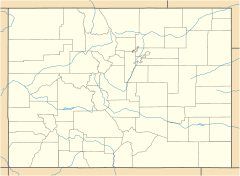- Marble Community Church
-
St. Paul's ChurchThe church in 2011.
Location: Marble, Colorado Coordinates: 39°4′16″N 107°11′21″W / 39.07111°N 107.18917°WCoordinates: 39°4′16″N 107°11′21″W / 39.07111°N 107.18917°W Built: 1908 Architectural style: Gothic Governing body: Private MPS: Historic Resources of Marble, Colorado and Vicinity NRHP Reference#: 89000990[1] Added to NRHP: August 3, 1989 Marble Community Church, formerly called St. Paul's Church is a historic Episcopal church at 123 State Street in Marble, Colorado. The church's main building was originally the building of the St. John’s Episcopal Chapel, which was built in Aspen, Colorado in 1886. The church was listed on the National Register of Historic Places in 1989.[1]
History
By the beginning of the 20th century, Marble was home to an active children's Sunday school, though the town lacked a church building for which to hold the school. In 1908, the one room St. John's Episcopal Chapel building, constructed in 1886 a short distance northeast of Marble in Aspen, was no longer required there and the diocese made it available for relocation to Marble. The chapel was dismantled and moved by railroad car to a new location at 123 State Street. The building was reassembled on two lots of land purchased with a $2500 donation by the Episcopal Women's Guild and renamed the St. Paul’s Church. Shortly after the installation of the building it was extended with the addition of two side rooms.[2] Further enlargement of the church was carried out in 1911, with the addition of a belfry containing a 500 pound bell.[2] The church represents an example of an early religious structure in a mining community and is the town's only example of Gothic architecture.[3]
St. Paul's Church was a center for religious and social activities and provided for three congregations: Episcopal, Union Congregational, and Catholic, as well as acting as a meeting place for other groups. The imminency of the approaching World War II however, brought about the closure of the town's local marble quarries and Marble Company mill. As a result the town saw a decline in its population which resulted in the closure of the church in 1941. The building was left empty and unused for a number of years remaining in the care of the Williams brothers.[2][3]
Over ten years later, in the early 1950s, permission was granted from the Williams brothers, to use the old church, was cleaned and used to hold prayer meetings and hymn singing services. The interest in these services grew, and shortly after they began a congregation had formed and adopted the name Marble Community Church. During the summers of 1960 and 1961 George A. Drake, who went on to become president of Grinnell College, served the congregation.[2] In 1974, the congregation received permission to move back into the old church in exchange for assuming responsibility for the care and maintenance of the building.
In 1983, The Marble Community Church became incorporated under the laws of Colorado and after negotiation the Rev. Fr. Cyril Coverly of the Episcopal Diocese was able to present the deed to the building and land back to the congregation on July 7, 1985.[3] The church was listed on the National Register of Historic Places in 1989 as a Historic Place in Gunnison County, Colorado.[1]
From 2002 to 2004, the church began renovations of the original church and the construction of a new fellowship hall with a grant from the Colorado Historical Society, donations from the community and volunteer labor allowing the project to be completed ahead of schedule. A breezeway to connect these two buildings was completed in 2004 and in July 2008 the Marble Community Church celebrated it's 100th Anniversary and the dedication of a marble angel sculpture by Connie Hendrix.[2]
References
- ^ a b c "National Register Information System". National Register of Historic Places. National Park Service. 2008-04-24. http://nrhp.focus.nps.gov/natreg/docs/All_Data.html.
- ^ a b c d e "Marble Community Church: History of Our Church". Marble Community Church. http://www.marblecommunitychurch.org/history.html. Retrieved 2010-09-15.
- ^ a b c "National & State Registers: Gunnison County". Office of Archaeology & Historic Preservation. Colorado Historical Society. http://www.coloradohistory-oahp.org/programareas/register/1503/cty/gn.htm. Retrieved 2010-08-23.
External links
U.S. National Register of Historic Places Topics Lists by states Alabama • Alaska • Arizona • Arkansas • California • Colorado • Connecticut • Delaware • Florida • Georgia • Hawaii • Idaho • Illinois • Indiana • Iowa • Kansas • Kentucky • Louisiana • Maine • Maryland • Massachusetts • Michigan • Minnesota • Mississippi • Missouri • Montana • Nebraska • Nevada • New Hampshire • New Jersey • New Mexico • New York • North Carolina • North Dakota • Ohio • Oklahoma • Oregon • Pennsylvania • Rhode Island • South Carolina • South Dakota • Tennessee • Texas • Utah • Vermont • Virginia • Washington • West Virginia • Wisconsin • WyomingLists by territories Lists by associated states Other  Category:National Register of Historic Places •
Category:National Register of Historic Places •  Portal:National Register of Historic PlacesCategories:
Portal:National Register of Historic PlacesCategories:- Religious buildings completed in 1908
- 20th-century Episcopal church buildings
- Episcopal churches in Colorado
- Properties of religious function on the National Register of Historic Places in Colorado
- Buildings and structures in Gunnison County, Colorado
Wikimedia Foundation. 2010.



